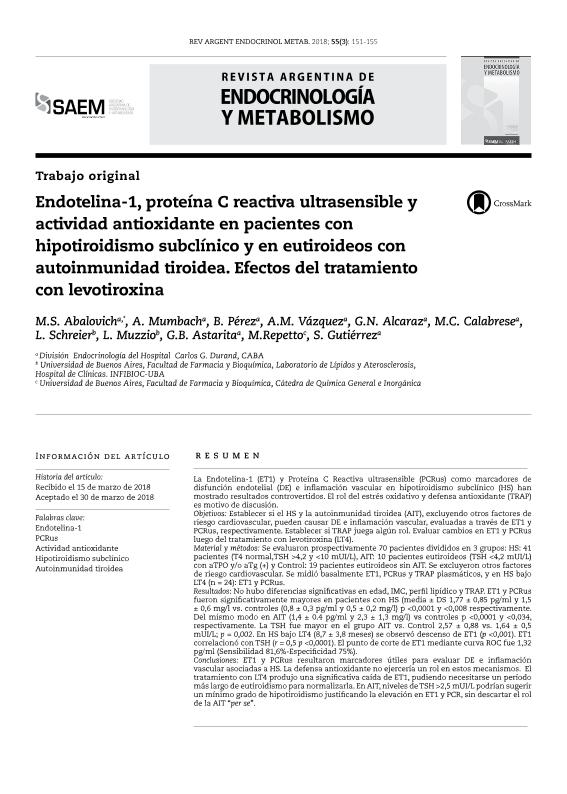Artículo
La Endotelina-1 (ET1) y Proteína C Reactiva ultrasensible (PCRus) como marcadores de disfunción endotelial (DE) e inflamación vascular en hipotiroidismo subclínico (HS) han mostrado resultados controvertidos. El rol del estrés oxidativo y defensa antioxidante (TRAP) es motivo de discusión. Objetivos: Establecer si el HS y la autoinmunidad tiroidea (AIT), excluyendo otros factores de riesgo cardiovascular, pueden causar DE e inflamación vascular, evaluadas a través de ET1 y PCRus, respectivamente. Establecer si TRAP juega algún rol. Evaluar cambios en ET1 y PCRus luego del tratamiento con levotiroxina (LT4). Material y métodos: Se evaluaron prospectivamente 70 pacientes divididos en 3 grupos: HS: 41 pacientes (T4 normal,TSH >4,2 y <10 mUI/L), AIT: 10 pacientes eutiroideos (TSH <4,2 mUI/L) con aTPO y/o aTg (+) y Control: 19 pacientes eutiroideos sin AIT. Se excluyeron otros factores de riesgo cardiovascular. Se midió basalmente ET1, PCRus y TRAP plasmáticos, y en HS bajo LT4 (n = 24): ET1 y PCRus. Resultados: No hubo diferencias significativas en edad, IMC, perfil lipídico y TRAP. ET1 y PCRus fueron significativamente mayores en pacientes con HS (media ± DS 1,77 ± 0,85 pg/ml y 1,5 ± 0,6 mg/l vs. controles (0,8 ± 0,3 pg/ml y 0,5 ± 0,2 mg/l) p <0,0001 y <0,008 respectivamente. Del mismo modo en AIT (1,4 ± 0.4 pg/ml y 2,3 ± 1,3 mg/l) vs controles p <0,0001 y <0,034, respectivamente. La TSH fue mayor en el grupo AIT vs. Control 2,57 ± 0,88 vs. 1,64 ± 0,5 mUI/L; p = 0,002. En HS bajo LT4 (8,7 ± 3,8 meses) se observó descenso de ET1 (p <0,001). ET1 correlacionó con TSH (r = 0,5 p <0,0001). El punto de corte de ET1 mediante curva ROC fue 1,32 pg/ml (Sensibilidad 81,6%-Especificidad 75%). Conclusiones: ET1 y PCRus resultaron marcadores útiles para evaluar DE e inflamación vascular asociadas a HS. La defensa antioxidante no ejercería un rol en estos mecanismos. El tratamiento con LT4 produjo una significativa caída de ET1, pudiendo necesitarse un período más largo de eutiroidismo para normalizarla. En AIT, niveles de TSH >2,5 mUI/L podrían sugerir un mínimo grado de hipotiroidismo justificando la elevación en ET1 y PCR, sin descartar el rol de la AIT “per se”. The measurement of endothelin-1 (ET1) and high sensitivity C-reactive protein (hsCRP) as markers of endothelial dysfunction (ED) and vascular inflammation in subclinical hypothyroidism (SH) has shown controversial results. The role of oxidative stress and antioxidant defense (TRAP) is a matter of discussion. Objectives: To establish if SH and thyroid autoimmunity (TAI), excluding other cardiovascular risk factors, may cause ED and vascular inflammation, evaluated through the measurement of ET1 and hsCRP respectively. To determine if TRAP could have some role. Additionally, changes in these parameters after treatment with levothyroxine (LT4) will be evaluated. Material and methods: 70 patients were prospectively evaluated. They were classified into: SH Group: 41 patients (normal T4, TSH> 4.2 and <10 mIU/L), TAI Group: 10 euthyroid patients (TSH <4.2 mUI/L) with positive aTPO and/or aTg and Control Group: 19 euthyroid patients without TAI. Other cardiovascular risk factors were excluded in patients and controls. Plasma ET1, hsCRP and TRAP were measured basally, and ET1 and hsCRP under LT4 therapy in the HS Group. Results: There were no significant differences between the 3 groups in age, BMI, lipids and TRAP. ET1 and hsCRP were significantly higher in patients with SH (mean ± SD 1.77 ± 0.85 pg/ml and 1.5 ± 0.6 mg/l) vs. controls (0.8 ± 0.3 pg/ml y 0.5 ± 0.2 mg/l) p <0.0001 y <0.008 respectively. Similarly, in TAI patients (1.4 ± 0.4 pg/ml y 2.3 ± 1.3 mg/l) vs controls, p <0.0001 and <0.034, respectively. TSH was higher in the TAI patients versus control group (2.5 ± 0.88 versus 1.64 ± 0.5 mIU/L, p = 0.002). Twenty-four patients with SH showed a significant decrease in ET1 (p <0.001) under treatment with LT4 (8.7 ± 3.8 months). ET1 had a highly significant correlation (p <0.0001) with TSH (r = 0.5). The cut-off level of ET1 established by ROC curve was 1.32 pg/ml (Sensitivity 81.6%-Specificity 75%). Conclusions: ET1 and hsCRP were useful markers to evaluate ED and vascular inflammation associated with SH. There were no differences in TRAP levels between patients and controls, so it does not appear that oxidative stress would have played any role. Treatment with LT4 produced a significant drop in ET1. Probably, a longer period of euthyroidism might be necessary to normalize ET1 levels. In TAI Group, TSH levels >2.5 mUI/L could suggest a “minimal degree” of hypothyroidism justifying the elevation in ET1 and hs CRP. The role of the TAI “per se” couldn’t be completely ruled out.
Endotelina-1, proteína C reactiva ultrasensible y actividad antioxidante en pacientes con hipotiroidismo subclínico y en eutiroideos con autoinmunidad tiroidea. Efectos del tratamiento con levotiroxina
Título:
Endothelin-1, high sensitivity C reactive protein and antioxidant activity in subclinical hypothyroid patients. Effects of levothyroxine treatment
Abalovich, Marcos Sergio; Mumbach, A.; Vázquez, A. M; Alcaraz, G. N.; Calabrese, M. C.; Schreier, Laura Ester; Muzzio, L.; Astarita, G. B.; Repetto, Marisa Gabriela ; Gutiérrez, S.
; Gutiérrez, S.
 ; Gutiérrez, S.
; Gutiérrez, S.
Fecha de publicación:
03/2018
Editorial:
Sociedad Argentina de Endocrinología y Metabolismo
Revista:
Revista Argentina de Endocrinologia y Metabolismo
ISSN:
0080-2077
Idioma:
Español
Tipo de recurso:
Artículo publicado
Clasificación temática:
Resumen
Palabras clave:
ENDOTELINA-1
,
PCRus
,
ACTIVIDAD ANTIOXIDANTE
,
HIPOTIROIDISMO SUBCLINICO
Archivos asociados
Licencia
Identificadores
Colecciones
Articulos(OCA HOUSSAY)
Articulos de OFICINA DE COORDINACION ADMINISTRATIVA HOUSSAY
Articulos de OFICINA DE COORDINACION ADMINISTRATIVA HOUSSAY
Citación
Abalovich, Marcos Sergio; Mumbach, A.; Vázquez, A. M; Alcaraz, G. N.; Calabrese, M. C.; et al.; Endotelina-1, proteína C reactiva ultrasensible y actividad antioxidante en pacientes con hipotiroidismo subclínico y en eutiroideos con autoinmunidad tiroidea. Efectos del tratamiento con levotiroxina; Sociedad Argentina de Endocrinología y Metabolismo; Revista Argentina de Endocrinologia y Metabolismo; 55; 3; 3-2018; 151-155
Compartir



